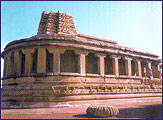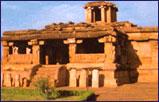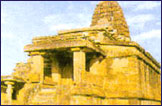|
Aihole
Places of interest
|
| Durga
Temple: |

|
The temple derives its name from Durgadagudi meaning 'temple
near the fort'. Dedicated to Vishnu, the temple appears to be a Hindu adaptation of the
Buddhist chaitya (hall) with its apsidal end. Standing on a high platform with a
'rekhanagara' type of Shikhara, it is the most elaborately decorated monument in Aihole.
The columns at the entrance and within the porch are carved with figures and ornamental
relief's. The temple appears to be a late 7th or early 8th century
construction. |
|
Ladh Khan Temple: |
The experimental nature of temple building by the Chalukyas is best elaborated in
the Ladh Khan Temple, located south of the Durga Temple. Not knowing how to build a
temple, they built it in the Panchayat hall style. The windows were filled up with lattice
work in the northern style and the sanctum was added later on. The sanctum is built
against the back wall and the main shrine has a Shivalinga along with a Nandi. Above the
center of the hall, facing the sanctum, is a second smaller sanctum with images carved on
the outer walls. |

|
The temple, built about 450 AD,
gets its name from a Muslim prince who converted it into his residence.
|
|
Gowda Temple: |
Close to Ladh Khan Temple & built in the similar lines,
the Gowda Temple was dedicated to Bhagavati. Standing on a high molded base and having
about 16 fairly plain pillars, this temple was probably built even earlier.
|
Hucchimalli Temple: |

|
This appears to be one of the earliest groups of temples in
Aihole, located to the north of village behind the Tourist Home. The sanctum has a
northern style "Rekhanagara" tower over it. The vestibule in front of the
sanctum was introduced for the first time here. |
|
Meguti Temple: |
The only dated monument in Aihole, the Meguti Temple was built atop a small hill
in 634 AD. Now partly in ruins, possibly never completed, this temple provides an
important evidence of the early development of the Dravidian style of Architecture. The
inscription dating the monument is found on one of the outer walls of the temple and
records its construction by Ravikeerti, who was a commander & minister of Pulakesin
II. Apparently a Jain Temple as seen from the |

|
seated Jain figure here, the
superstructure rising above the sanctum wall of the temple is not original & the
16-columns porch and hall extension are later additions. |
|
Ravanphadi Cave: |

|
Located south-east of the Hucchimalli Temple, this rock-cut temple is assigned to
the 6th century. The sanctum in there are wall is larger than these in Badami cave temples
and it is provided with a vestibule flanked by carved panels, entered through a triple
entrance. Despite the variety of images found here, the Mahishasuramardhini, the great
Dancing Shiva linga with Ganesha and sapta-matrikas and the linga inside the sanctum an
overall Shiva application. |
|
Konti Group of Temples: |
Situated in the middle of bazaar, the earliest of these
temples was probably built in the 5th century. The first temple has panels of
Bramha, Shiva & a reclined Vishnu on the ceiling.
|
Top |
|